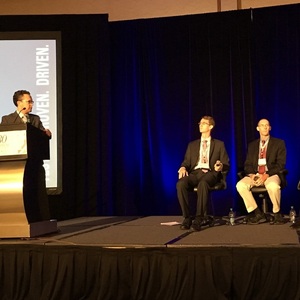ACE conference addresses barriers to blending more ethanol

BBI International
August 17, 2017
BY Lisa Gibson
Fuel consumers and retailers are looking for more options and higher octanes, according to the three speakers on the Aug. 17 general session panel of the American Coalition for Ethanol Annual Conference in Omaha.
The panel, titled “Shifting to High-Octane Fuel,” focuses on the infrastructure, research and regulation needed to do that. Ethanol is an efficient octane booster, said Brian West, deputy director and senior development staff member of the Fuels, Engines and Emissions Research Center at the U.S. Department of Energy’s Oak Ridge National Laboratory. West discussed ORNL’s research into ethanol in different types of engines, showing certain ethanol blends add speed and boost to certain vehicles. “There’s an efficiency gain to be had there,” he said. “There’s performance gain to be had there.”
The road fuel infrastructure for a mid-level blend is not trivial, West said. E25 or E30 has the prospect to be the “new regular.” Fellow panelist Trey Binford, product manager of North America dispensers at Wayne Fuel Systems, addressed what Wayne is doing to develop that infrastructure. It’s crucial, he cautioned, to make sure consumers aren’t confused at the pump. “Not breaking the user experience is important to this industry,” he said.
Advertisement
Advertisement
Wayne also wants its fuel retailer customers to have dispensers that are upgradable or ready for future fuel options, Binford said. But it has to be consistent, with ethanol offered at all pumps, he added. “Build a consistent experience across the site for the consumer.”
Binford outlined options to make Wayne’s E25 standard widely available to consumers at pumps, using a three-hose system. The appearance and usability of the pump is important. “If we’re able to market E15 alongside the other products, we believe you’ll be able to sell a lot more of it.”
Adam Gustafson, partner at Boyden Gray & Associates, capped the presentations with his discussion on policy and leadership. A portion of his presentation revolved around the Reid vapor pressure waiver issue the ethanol industry is dealing with in its E15 blends. The U.S. Environmental Protection Agency interprets a law in the Clean Air Act to mean that only fuels with ethanol blends up to 10 percent should get the waiver, but Gustafson said the EPA needs to reinterpret that law. “It not only makes sense technically, it makes sense environmentally. … It’s really irrational to impose a higher standard on E15.” The future of current legislation to grant E15 the waiver is uncertain, he said, and the ethanol industry needs to confront the reality that action on that legislation won’t be swift.
If EPA wants to limit ethanol concentration, it must use a separate Clean Air Act provision, which requires a finding that the fuel harms public health or emissions control devices, Gustafson said. “The EPA can still regulate fuel content, but it has to find a reason to do that. And we don’t think it can.” Because adding ethanol to fuel reduces emissions, he said.
Advertisement
Advertisement
Related Stories
The U.S. Energy Information Administration maintained its forecast for 2025 and 2026 biodiesel, renewable diesel and sustainable aviation fuel (SAF) production in its latest Short-Term Energy Outlook, released July 8.
XCF Global Inc. on July 10 shared its strategic plan to invest close to $1 billion in developing a network of SAF production facilities, expanding its U.S. footprint, and advancing its international growth strategy.
U.S. fuel ethanol capacity fell slightly in April, while biodiesel and renewable diesel capacity held steady, according to data released by the U.S. EIA on June 30. Feedstock consumption was down when compared to the previous month.
XCF Global Inc. on July 8 provided a production update on its flagship New Rise Reno facility, underscoring that the plant has successfully produced SAF, renewable diesel, and renewable naphtha during its initial ramp-up.
The U.S. EPA on July 8 hosted virtual public hearing to gather input on the agency’s recently released proposed rule to set 2026 and 2027 RFS RVOs. Members of the biofuel industry were among those to offer testimony during the event.
Upcoming Events










